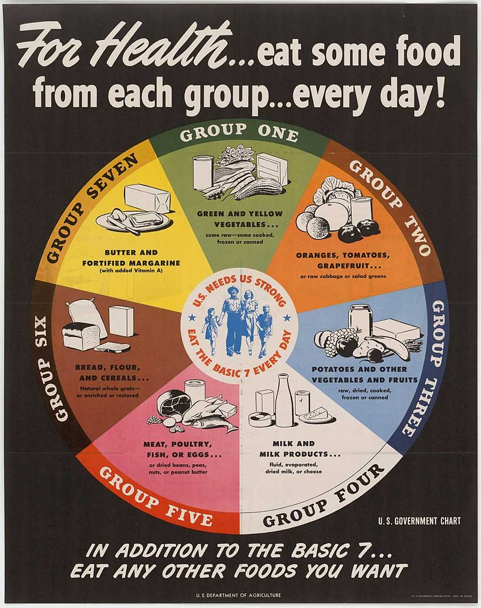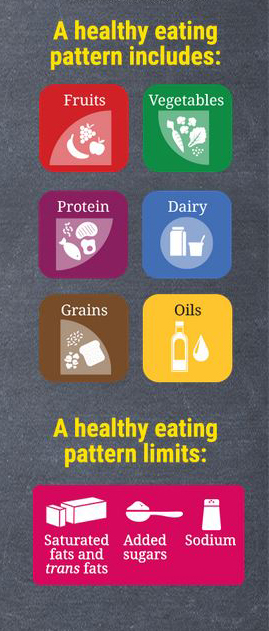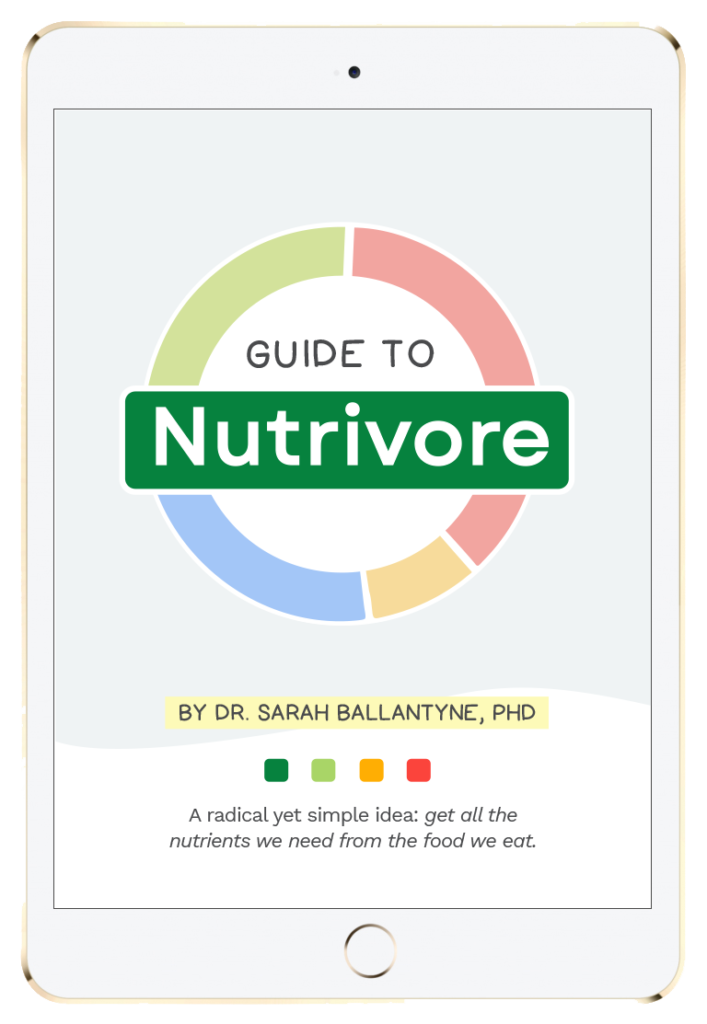Since their beginnings in 1894, various United States Department of Agriculture (USDA) nutrition guidelines have been criticized as not accurately representing scientific information about optimal nutrition and being inappropriately influenced by the agriculture industry. The earliest guidelines justifiably focused on avoiding malnutrition and starvation, problems that were rampant in many areas at that time. The 1916 guidelines introduced food groups, and their recommendation to liberally consume foods from five groups—milk and meat, cereals, vegetables and fruits, fats and fatty foods, and sugars and sugary foods—successfully targeted the issue of gross malnutrition.
Table of Contents[Hide][Show]

In 1943, the USDA updated its guidelines to what was called the “Basic 7,” which, flawed as it was, was a noble attempt at creating food groups based on micronutrients. The scientific understanding of essential nutrients was in its infancy in the early 1940s: the roles of many minerals in the human body, as well as the very existence of many of the vitamins that we now know are necessary for survival, had yet to be discovered. However, the Basic 7 guidelines were on the right track with a partial shift away from the previous focus on energy and toward a focus on micronutrients. While some of the earlier food groups remained, vegetables and fruits were divided into three different categories based on the few micronutrients that were known to exist at the time. For example, oranges, tomatoes, grapefruit, salad greens, and cabbage formed one food group based on their high levels of vitamin C. Butter got its own food group thanks to its vitamin A content. While we certainly would come up with different micronutrient-based food groups now, the Basic 7 was a good effort and a move in the right direction.
Unfortunately, the Basic 7 was met with skepticism and confusion by the public. Policymakers decided that, in order to be successful, the dietary guidelines needed to be simplified. And with the newly established Recommended Dietary Allowances providing a target for daily dietary intake of each essential micronutrient, it was simpler to stop basing food groups on nutrients.
The pinnacle of dietary guideline simplicity was achieved in the next update. The “Basic 4” enjoyed the longest reign of all the USDA dietary recommendations, from 1956 until 1992. The rules of how to choose foods could be communicated in 30 seconds or less: two to four servings from the milk group, two or more servings from the meat group, four or more servings from the vegetables and fruit group, and four or more servings from the bread and cereal group, “plus other foods as needed to complete meals and to provide additional food energy and other food values.” The problem was that the foods in each group varied widely in terms of nutrients, so choosing foods using that framework in no way ensured adequate nutrition.
When the Basic 4 was finally revamped for subsequent USDA dietary guidelines, including the Food Guide Pyramid, MyPyramid, and MyPlate, vegetables and fruits were divided into their own food groups. Yet the only appreciable differences among all the dietary recommendations of the last sixty years are the number of servings suggested from each food group and the way the information is presented visually.
With the public’s rejection of the Basic 7, the idea of basing dietary recommendations on micronutrient content was lost. Instead of dividing foods into groups based on the micronutrients they contain, the guidelines based the food groups on how the foods are produced. As a result, and compounded by the increase in consumption of manufactured and refined foods, nutrient deficiencies have become rampant. And nutrient deficiency may be one of the biggest contributors to the rise in chronic illnesses seen in recent decades. See 7 Nutrients You’re Probably Deficient In, The Importance of Nutrient Density
For more on the history of dietary guidelines and how they’ve steered us wrong, I recommend reading Death by Food Pyramid by Denise Minger.

Apathy for Dietary Guidelines
The USDA’s 2015–2020 Dietary Guidelines for Americans represent a shift back toward a micronutrient focus, with recommendations to eat a variety of nutrient-dense foods from each of six food groups, a division of vegetables into five subgroups, and an emphasis on avoiding excess caloric intake and added sugar while eschewing refined and manufactured foods. And while many of the advances in this newest revamp are a giant leap in the right direction, another major problem has emerged: hardly anyone is paying attention anymore.
The last sixty years of steadily increasing rates of chronic disease have proven that distilling dietary recommendations to a simple set of rules is not an effective strategy to support public health. Instead, the public has become distrustful of dietary guidelines and the authorities making them, dogmatic in their own approaches to nutrition and more likely to subscribe to fad diets and/or be completely apathetic toward food, feeling like “eating right” isn’t worth the effort.
Fewer than 10% of Americans choose most of their foods according to the USDA dietary guidelines. This is a strong indicator that it doesn’t work to communicate dietary guidelines as a set of rules without explaining why one food is a better choice than another. Humans are instinctively rebellious against arbitrary rules and unmerited authority. If we’re expected to follow rules about what we eat, especially when following those rules means avoiding addictive, hyperpalatable junk foods and most convenience foods, those rules had better be well founded, and we need to understand where they come from. Whether dietary guidelines are distilled to recommended servings from four food groups or twenty, what’s missing isn’t a fancy graphic but the reasoning behind the recommendations.
That’s why my approach to improving public health relies on increasing scientific literacy on health-related topics. Infographics then simply serve as a visual review.
Nutrivore Weekly Serving Matrix
An easy-to-use and flexible weekly checklist
to help you maximize nutrient-density.
The Weekly Serving Matrix is very helpful! I’ve been eating along these lines but this really helps me know where to focus vs. which foods serve a more secondary role. It’s super helpful and has taken a lot of worry out of my meal planning. Thanks!
Jan
Dietary Guidelines and the Rise in Chronic Illness Video
Enjoy this free preview lecture from my AIP Lecture Series online intensive course. This is one of the introductory lectures, specifically Week #1, Lecture #2, and one of 42 lectures included in this online course!. In this video, I discuss the history of dietary recommendations and how they’ve contributed to the rise in chronic illness. Unfortunately, many of the things that we’ve been taught about nutrition over the past few decades is wrong. The good news is that all of the diet and lifestyle information presented in my books, website, and online courses is evidence-based.
The AIP Lecture Series is a 6-week video-based online course in which I provide individualized guidance and support while teaching you the scientific foundation for the diet and lifestyle tenets of the Autoimmune Protocol (AIP), plus provide you with tons of tips and strategies for implementation, refinement and troubleshooting! This course is geared at autoimmune and chronic disease sufferers and their caregivers, but is full of awesome information for anyone looking to expand their knowledge of nutritional sciences.
Learn More about the AIP Lecture Series
Education vs Infographics
Let’s turn the tide of public health and rediscover what it feels like to be healthy. Doing so starts with a dietary template that is solidly rooted in physiology and nutritional sciences, uninfluenced by special interests, and communicated with a thorough explanation of the origins of each facet of that template.
Nutritional science has come a long way since the first half of the twentieth century, when its primary focus was identifying micronutrients and establishing their recommended daily intakes. Now, our understanding of how nutrients (both those deemed essential and those currently considered nonessential) and other compounds in food act in the body to promote or undermine health spans many disciplines of science. There are tens of thousands of scientific articles on the topic, each examining one small piece of the puzzle. And while we still don’t have all the pieces, when we put together what we do know, we find that the average American diet is far from an optimal human diet. And, while the USDA dietary guidelines are finally getting closer to the mark, there’s plenty of room for improvement.
My approach to dietary guidelines stops making repetitive changes to a flawed dietary guideline system, and instead goes back to the drawing board and builds a template based on current scientific knowledge. Learn more in my e-book The Paleo Template and my epic Paleo guidebook Paleo Principles
Whether you’re looking to lose weight, manage diabetes, reduce risks of cancer and cardiovascular disease, mitigate autoimmune disease, or improve performance or you simply want to experience the best health possible, a diet that is abundant in all the micronutrients and simultaneously omits foods known to be problematic for health is your best bet (see Modifying Paleo to Meet Your Goals). What does this diet look like? Its foundation is the most micronutrient-dense foods available, including organ meat, seafood, and both a huge variety and copious quantities of vegetables, with other quality meats, fruit, eggs, nuts, seeds, healthy fats, probiotic and fermented foods, herbs, and spices to round it out. At the same time, it omits foods known to be inflammatory, disrupt hormones, or negatively impact the health of the gut, including most grains, many legumes, conventional dairy products, and all processed and refined foods. Each principle is rooted in scientific evidence, stripped of dogma and a perfect-or-bust attitudes, respecting bioindividuality, admitting the boundaries of current human knowledge, open to adjustment to reflect new compelling science, and empowering you not with yes-no food lists, but with a solid knowledge base to inform your day-to-day decisions.
Yes, this is the Paleo template.
Looking for more detailed information but not Autoimmune Protocol-specific? Check out my e-book The Paleo Template, my epic Paleo guidebook Paleo Principles and my awesome and comprehensive online course collection the Foundations of Health.








 AIP Do’s and Don’ts
AIP Do’s and Don’ts